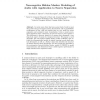Free Online Productivity Tools
i2Speak
i2Symbol
i2OCR
iTex2Img
iWeb2Print
iWeb2Shot
i2Type
iPdf2Split
iPdf2Merge
i2Bopomofo
i2Arabic
i2Style
i2Image
i2PDF
iLatex2Rtf
Sci2ools
ICA
2010
Springer
2010
Springer
Non-negative Hidden Markov Modeling of Audio with Application to Source Separation
Abstract. In recent years, there has been a great deal of work in modeling audio using non-negative matrix factorization and its probabilistic counterparts as they yield rich models that are very useful for source separation and automatic music transcription. Given a sound source, these algorithms learn a dictionary of spectral vectors to best explain it. This dictionary is however learned in a manner that disregards a very important aspect of sound, its temporal structure. We propose a novel algorithm, the non-negative hidden Markov model (N-HMM), that extends the aforementioned models by jointly learning several small spectral dictionaries as well as a Markov chain that describes the structure of changes between these dictionaries. We also extend this algorithm to the non-negative factorial hidden Markov model (N-FHMM) to model sound mixtures, and demonstrate that it yields superior performance in single channel source separation tasks.
Hidden Markov Model | ICA 2010 | Non-negative | Non-Negative Matrix Factorization | Signal Processing |
| Added | 09 Nov 2010 |
| Updated | 09 Nov 2010 |
| Type | Conference |
| Year | 2010 |
| Where | ICA |
| Authors | Gautham J. Mysore, Paris Smaragdis, Bhiksha Raj |
Comments (0)

